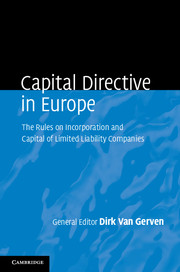31 - Norway
from Part III - Application in the EEA Member States
Published online by Cambridge University Press: 05 June 2014
Summary
Implementation and scope
The Second Company Law Directive (Directive 77/91/EEC, as amended by Directive 92/101/EEC) was implemented into Norwegian law by the Act of 22 December 1995 No 80. The Norwegian parliament has given its consent to inclusion of the amendments introduced by Directive 2006/68/EC in the EEA Agreement, but the exemptions provided for in the Directive have not been implemented into Norwegian law.
The scope of the Second Company Law Directive is limited to public limited liability companies. According to the EEA Agreement, the allmennaksjeselskap (“ASA”) is the public limited liability company under Norwegian law to which the Directive applies. The Norwegian legislature has, to a large degree, resolved similar rules in relation to aksjeselskap (“AS”), the private limited liability company under Norwegian law. These two types of limited liability companies are governed by different acts. The Norwegian Public Limited Companies Act of 13 June 1997 (“the PLC Act”) applies only to companies with limited liability which are described as allmennaksjeselskap in the articles of association and registered as such in the Norwegian Register of Business Enterprises. The following description of Norwegian law relates only to ASAs and the PLC Act.
- Type
- Chapter
- Information
- Capital Directive in EuropeThe Rules on Incorporation and Capital of Limited Liability Companies, pp. 1017 - 1040Publisher: Cambridge University PressPrint publication year: 2014



